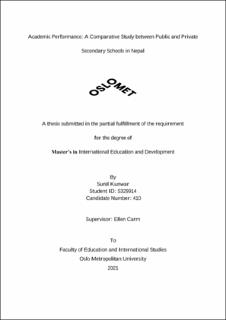| dc.description.abstract | The purpose of this research was to determine the causes of the academic performance gap between Nepal's public secondary schools and private secondary schools. Four study goals were addressed: to find out which school performs better between public and private secondary school; to examine the reasons why one of the secondary schools between public and private outperform; to compare the resources available in public school and private school; as well as the motivation of instructors in public school and private school.
A case study design was used. Among the target population in Ramchaur were 8 secondary school students and 8 secondary educators. There were also 8 parents and 2 school principals involved in the project as well as a district secondary education officer. On-the-spot observations, questionnaires and interviews as well as document analysis were utilized to gather data. The gathered data was interpreted using qualitative data analysis. The passing percentage of the private school was 100, whereas the passing percentage of the public school was between 48 to 54 percent in the past three academic years in the SEE, showing clearly that private school outperformed the public school. The private secondary school performed better than the public secondary school, according to approximately six out of eight teachers and parents, because it recruited qualified teachers, paid their teachers well, provided teaching and learning tools, had a well-established school management team (SMT) control system, and had a sound enrollment system for students. The primary findings revealed that in private secondary school, almost 7 out of 8 parents and teachers agreed in private secondary schools with committed instructors, financial capability, excellent and knowledgeable school managers, and active inspectorate personnel, the amount of engagement of school managers in decision-making on school matters is critical. In addition, the results showed that delegation of duties was the most incentive used by two of the schoolheads which is 100 percent to increase the performance of private secondary school teachers in the classroom. The last argument is that government efforts have been intensified to guarantee that secondary school education is uniform. These private and public secondary schools must work together to reduce or decrease the divide that has developed between them. Government must now guarantee that secondary schools have all public school amenities. | en_US |
